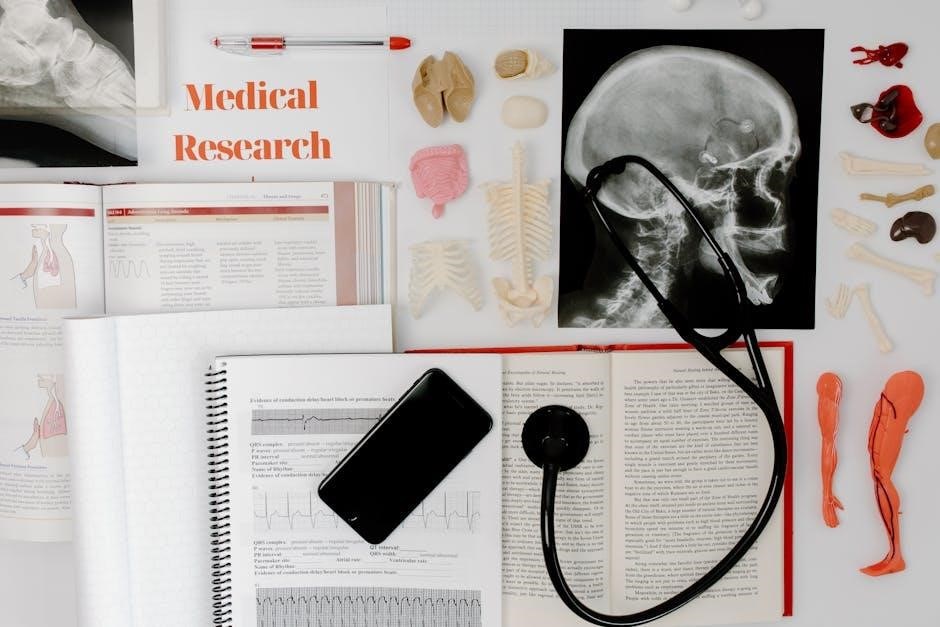anatomy drawing books pdf
- Published
- in PDF
Anatomy drawing books, including readily available PDF versions, are crucial resources for artists seeking to master realistic figure depiction.
These resources, like e-Anatomy, offer detailed anatomical references,
enhancing understanding of form and structure for improved artistic skill.
Why Use Anatomy Books for Drawing?

Anatomy books, and increasingly, anatomy drawing books in PDF format, are foundational for artists aiming to move beyond superficial representation. Understanding the underlying skeletal and muscular structures allows for the creation of figures with believable weight, balance, and movement. Simply copying what you see limits artistic growth; knowing what lies beneath unlocks a deeper level of realism and expressiveness.
These resources aren’t just about memorizing names; they’re about visualizing form in three dimensions. Resources like e-Anatomy provide interactive views, supplementing traditional study. PDF versions offer portability and accessibility, allowing artists to study anatomy anywhere, anytime.
Furthermore, anatomical knowledge informs artistic choices. Knowing where muscles attach dictates how drapery falls, and understanding bone structure clarifies how light interacts with the form. Even stylized art benefits from a solid anatomical foundation – deviations from realism are more impactful when understood in relation to realistic anatomy. Bridgman’s approach, detailed in his books, emphasizes understanding mass and form, a principle reinforced by anatomical study. Ultimately, anatomy books empower artists to create work that is both technically proficient and artistically compelling.

Digital vs. Physical Anatomy Drawing Books (PDFs)
The debate between physical anatomy drawing books and their PDF counterparts centers on convenience, cost, and learning style. Traditional books offer a tactile experience – the ability to physically flip pages, make annotations directly on the paper, and appreciate the quality of illustrations. However, they can be expensive and cumbersome to carry.
PDF versions, readily available online, provide portability and affordability. Artists can access a vast library of anatomical resources on tablets, laptops, or even smartphones. Features like zoom functionality are invaluable for studying intricate details, as seen in resources like e-Anatomy. Searching within a PDF is also significantly faster than indexing a physical book.
However, digital formats can strain the eyes during prolonged use, and the lack of tactile feedback may not suit all learners. Furthermore, ensuring the legality and ethical sourcing of PDF downloads is crucial. Ultimately, the best format depends on individual preferences and needs. Many artists find a blended approach – utilizing physical books for foundational study and PDFs for on-the-go reference – to be most effective.

Essential Anatomy Books for Artists

Essential anatomy books, often found as PDF downloads, include titles by Bridgman, Loomis, and Zarins/Kondrats. These resources, alongside e-Anatomy, provide artists with
foundational knowledge for accurate figure drawing.
“Anatomy for Sculptors” by Uldis Zarins and Sandis Kondrats
“Anatomy for Sculptors”, frequently sought in PDF format, stands out as a modern and exceptionally detailed anatomical guide tailored specifically for artists. Unlike traditional anatomy texts focused solely on medical accuracy, Zarins and Kondrats prioritize the understanding of forms as they relate to artistic representation. The book meticulously breaks down muscle groups and skeletal structures, emphasizing their three-dimensional qualities – a crucial aspect for both sculpting and drawing.
Its strength lies in its clear, visually-driven approach. Numerous illustrations, often featuring dynamic poses, demonstrate how anatomical structures interact during movement. This is particularly valuable for artists aiming to capture realistic and expressive figures. The authors don’t just present anatomy; they explain how anatomy influences surface form, helping artists to visualize and render the body with greater accuracy and nuance.
While physical copies are highly regarded, the availability of PDF versions allows for convenient study and reference. Artists can easily zoom in on details, annotate diagrams, and access the information on various devices. It’s a cornerstone resource for those serious about mastering human anatomy for artistic purposes.
“Classic Human Anatomy in Motion” by Valerie L. Winslow
“Classic Human Anatomy in Motion” by Valerie L. Winslow is a highly recommended resource, often found as a PDF download, for artists seeking a dynamic understanding of the human form. Winslow’s approach differs from static anatomical studies by focusing on how muscles and bones function during movement. This emphasis is invaluable for creating believable and expressive poses in drawings and sculptures.
The book excels in its detailed analysis of muscle groups as they contract and stretch, illustrating how these actions affect surface anatomy. Winslow doesn’t simply present anatomical facts; she explains the mechanics behind them, enabling artists to predict how the body will deform and shift weight. This knowledge is crucial for avoiding anatomical inaccuracies and achieving a sense of realism.
The availability of a PDF version makes this a particularly accessible resource. Artists can easily study the dynamic illustrations and refer to specific muscle groups while working. It’s a powerful tool for anyone looking to move beyond rote memorization and truly understand the principles of human anatomy in motion.
“Figure Drawing: For All It’s Worth” by Andrew Loomis
“Figure Drawing: For All It’s Worth” by Andrew Loomis remains a cornerstone text for aspiring artists, frequently sought after in PDF format due to its enduring relevance. Loomis’s instructional style is remarkably clear and approachable, breaking down complex anatomical concepts into manageable steps; He emphasizes constructing the figure using simple forms, building a solid foundation before adding detail.
Unlike purely anatomical texts, Loomis focuses on applying anatomical knowledge to drawing. He teaches artists how to “think” in three dimensions, understanding how forms turn in space and how light interacts with them. The book’s numerous illustrations demonstrate his techniques effectively, providing visual guidance for every stage of the drawing process.
The widespread availability of a PDF copy has ensured Loomis’s teachings continue to influence generations of artists. It’s a practical guide, offering exercises and advice that can be immediately implemented. While anatomical accuracy is important, Loomis prioritizes capturing the essence of the figure and conveying its weight and movement.

Understanding Anatomical References
Anatomy drawing books, often found as PDF downloads, provide essential skeletal, muscular, and surface anatomy knowledge.
These references, like e-Anatomy, are vital for artists aiming for accurate and believable figure depictions.
Skeletal Anatomy for Artists
Skeletal anatomy forms the foundational structure for any figure drawing, and dedicated anatomy drawing books – frequently accessible as PDF resources – are invaluable tools. Understanding the underlying bone structure dictates form and movement, enabling artists to create convincing poses and proportions. Resources like e-Anatomy offer detailed, interactive skeletal views, pinpointing specific bones and their relationships.
Artists benefit from studying not just individual bones, but also the skeletal landmarks visible on the surface. These landmarks act as guides for muscle attachment and overall form. PDF versions of classic texts often include detailed illustrations showcasing these key points. Knowing the skeletal proportions – the relative lengths of limbs, the size of the skull – is crucial for avoiding common anatomical errors.
Furthermore, understanding how bones articulate at joints is essential for depicting realistic movement. Anatomy drawing books, including those in PDF format, illustrate the range of motion possible at each joint, helping artists to avoid stiff or unnatural poses. Mastering skeletal anatomy is the first step towards truly understanding the human form.

Muscular Anatomy for Artists
Muscular anatomy is paramount for artists aiming to depict realistic and dynamic figures, and comprehensive anatomy drawing books – often found as convenient PDF downloads – are essential study tools. Understanding muscle origins, insertions, and actions allows for accurate representation of form and movement. Resources like e-Anatomy provide detailed muscular layers, aiding in visualization.
Artists shouldn’t simply memorize muscle shapes, but rather understand how muscles work in groups to create movement. PDF versions of classic texts frequently illustrate these muscle groups and their functions. Studying surface anatomy – the visible contours of muscles beneath the skin – is crucial for capturing realistic form. Knowing how muscles bulge and stretch during different poses adds dynamism to artwork.

Furthermore, understanding the relationship between muscles and underlying skeletal structure is vital. Anatomy drawing books, including PDF versions, demonstrate how muscles attach to bones and influence movement. Mastering muscular anatomy elevates figure drawing from simple outlines to believable, three-dimensional forms.
Surface Anatomy and Landmarks
Surface anatomy, the visible external features reflecting underlying structures, is a cornerstone of effective figure drawing, and readily accessible anatomy drawing books in PDF format are invaluable for its study. Artists must learn to identify key landmarks – bony prominences and soft tissue contours – that indicate deeper anatomical structures. These landmarks serve as guides for accurately placing muscles and bones.
Resources like e-Anatomy offer detailed visual references for surface anatomy, showcasing how anatomical structures manifest on the skin’s surface. Understanding these landmarks allows artists to simplify complex anatomy, focusing on essential forms. PDF versions of classic texts often include illustrations emphasizing these visible features.
Learning to ‘read’ the surface form – recognizing subtle changes in contour that reveal underlying anatomy – is a skill honed through consistent practice and study. Utilizing anatomy drawing books, especially in convenient PDF form, facilitates this process, enabling artists to create more convincing and lifelike depictions of the human figure.
Utilizing Cross-Sectional Anatomy Resources
Cross-sectional anatomy, visualized through PDF resources like e-Anatomy and medical scans (CT/MRI), provides artists with a deeper understanding of form.
These tools reveal internal structures,
enhancing realistic depictions.
e-Anatomy: A Comprehensive Online Atlas
e-Anatomy stands out as a premier online resource, offering a remarkably detailed and interactive exploration of human anatomy. Accessible via web, iOS, and Android devices, it functions as a comprehensive atlas, proving invaluable for artists seeking to refine their understanding of the human form. Unlike traditional anatomy drawing books or static PDF guides, e-Anatomy allows for dynamic visualization, enabling users to rotate and dissect anatomical structures in a virtual environment.
The platform’s strength lies in its pinpointed detailed views across various anatomical regions, coupled with imaging modalities like CT and MRI scans. This is particularly beneficial for artists aiming for accuracy, as it bridges the gap between surface anatomy and underlying structures. It’s more than just a visual reference; it’s a learning tool that facilitates a deeper comprehension of how muscles, bones, and organs interact.
For artists working with digital mediums, the ability to access such a detailed resource online is a significant advantage. While PDF versions of anatomy books offer portability, e-Anatomy’s interactive features and constantly updated content provide a more immersive and effective learning experience. It’s a modern approach to anatomical study, perfectly suited for the demands of contemporary art creation.
Importance of CT and MRI Scans in Anatomical Study
While traditional anatomy drawing books and PDF resources provide foundational knowledge, integrating cross-sectional anatomy – visualized through CT and MRI scans – elevates an artist’s understanding to a new level of precision. These imaging techniques reveal internal structures invisible to the naked eye, offering a three-dimensional perspective crucial for accurate figure depiction.
Understanding how muscles and bones appear in cross-section allows artists to convincingly portray form and weight, moving beyond superficial representations. Resources like e-Anatomy expertly incorporate these scans, demonstrating how anatomical structures relate to surface landmarks. This is particularly valuable when studying complex forms or dynamic poses.
For artists seeking hyperrealism, or those working with anatomical accuracy as a core principle, studying CT and MRI scans is indispensable. Even when relying on PDF guides, supplementing that study with cross-sectional imagery provides a deeper, more nuanced understanding. It allows for a more informed interpretation of anatomical illustrations and a more compelling artistic outcome, bridging the gap between artistic vision and anatomical reality.

Bridgman’s Books and Their Impact
Bridgman’s works, like “Book of a Hundred Hands,” profoundly impacted figure drawing. His focus on form and mass, even in PDF format, remains influential for artists today, emphasizing structural understanding.
“Book of a Hundred Hands” by George Bridgman
George Bridgman’s “Book of a Hundred Hands” is a cornerstone resource for artists, readily available in PDF format for convenient study. Published in 1920, this volume doesn’t simply present hands as static objects; it dissects them into fundamental forms, emphasizing the underlying anatomy and structural relationships. Bridgman’s approach focuses on breaking down complex shapes into simpler, manageable components – blocks, cylinders, and wedges – allowing artists to construct believable hands from a foundational understanding.
The book features numerous dynamic poses and variations, showcasing hands in action and illustrating how they interact with other body parts. It’s not about copying; it’s about learning to build a hand, understanding the flow of muscles and bones beneath the skin. Even in a digital PDF version, the quality of the illustrations remains impactful, demonstrating Bridgman’s mastery of line and form.
Artists benefit from studying the book’s emphasis on gesture and movement, learning to capture the essence of a hand’s expression. The repetitive nature of the studies – hence, “a hundred hands” – reinforces these principles, building muscle memory and improving observational skills. Finding a quality PDF copy allows for easy access and portability, making it a valuable tool for artists on the go.
Bridgman’s Approach to Form and Mass
George Bridgman’s artistic philosophy, extensively detailed in his books – often found as accessible PDF downloads – centers on understanding form as a series of interconnected masses. He rejected purely linear approaches, instead advocating for a construction-based method where the body is built from simplified geometric shapes. This isn’t about creating rigid, blocky figures, but rather establishing a solid foundation upon which to layer detail and nuance.
Bridgman emphasized that every form, even the most organic, can be reduced to fundamental planes and volumes. He believed that drawing should follow a line, a plane, or a mass, and that mastering these elements is crucial for conveying weight, solidity, and three-dimensionality. His books, including digital PDF versions, are filled with illustrations demonstrating this principle, showing how muscles and bones translate into visible forms.
This approach allows artists to visualize the underlying structure, even when obscured by clothing or in dynamic poses. Studying Bridgman’s work, even through a PDF, encourages a deeper understanding of anatomy and how it influences surface form. It’s a method that prioritizes structural integrity and believable weight, resulting in more compelling and realistic figures.

Finding Anatomy Drawing Books in PDF Format
Numerous anatomy drawing books are available as PDF downloads, offering convenient access to essential resources. However, always prioritize legal and ethical sourcing to respect copyright regulations.
Legal and Ethical Considerations of PDF Downloads
Downloading anatomy drawing books in PDF format raises significant legal and ethical concerns. Copyright laws protect the intellectual property of authors and publishers, and unauthorized distribution constitutes infringement. Obtaining PDFs through illegal channels, such as torrent sites or unofficial repositories, not only violates these laws but also undermines the creative process and the livelihoods of artists and educators.
Ethically, supporting creators by purchasing their work demonstrates respect for their effort and expertise. Many legitimate platforms offer digital versions of anatomy books for purchase or subscription, ensuring fair compensation for the authors. Utilizing these avenues supports the continued production of high-quality educational resources.
Furthermore, illegally obtained PDFs may contain malware or viruses, posing a security risk to your devices. Reputable sources prioritize user safety and adhere to industry standards. Always verify the legitimacy of a source before downloading any digital content. Consider library access or purchasing directly from publishers to ensure ethical and safe access to these valuable learning tools.
Reputable Sources for Anatomy PDFs
Finding legitimate PDF versions of anatomy drawing books requires careful sourcing. Several platforms offer legally compliant digital copies. Book retailers like Amazon Kindle and Google Play Books frequently stock anatomy titles in PDF format, ensuring authors receive royalties. Publisher websites, such as those of Watson-Guptill or Dover Publications, often provide direct digital downloads.
Subscription services like Proko offer access to anatomy resources, including downloadable materials, as part of their learning packages. Educational platforms and online art schools may also provide PDF study guides or excerpts from relevant books to enrolled students.
Libraries are an excellent resource, with many offering digital lending programs that include ebooks and PDFs. Always prioritize sources that clearly indicate copyright compliance and offer secure download options. Avoid websites promising “free” PDFs of copyrighted material, as these are likely illegal and potentially harmful. Supporting legitimate vendors ensures continued access to quality anatomical references.
